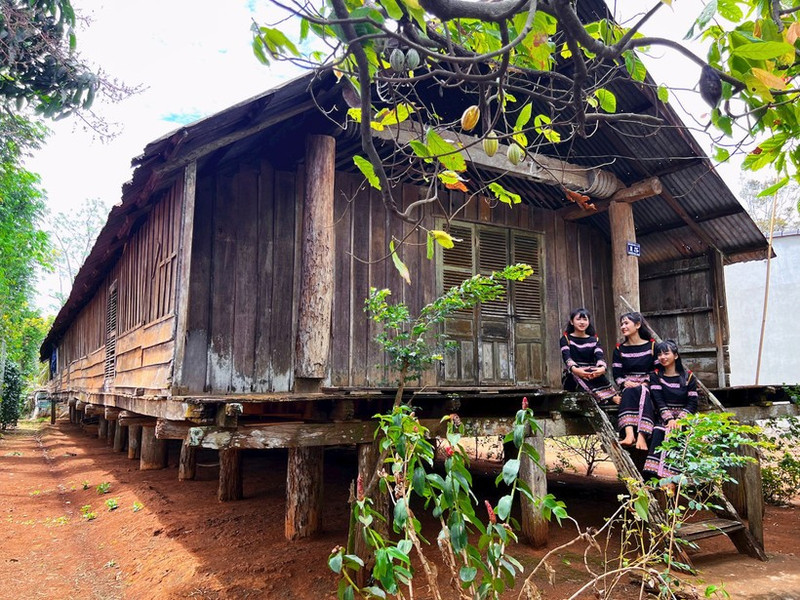When speaking of the Central Highlands, the most iconic cultural image is that of the traditional nha rong (communal stilt house) or longhouses built by the region’s ethnic communities. As time brings inevitable change, these spaces - once the shelter of families and the heart of communal culture - have not been immune to wear and tear. However, efforts to restore, preserve, and promote traditional architecture across Central Highlands provinces in recent years are showing promising signs.

The E De longhouse in Kmrơng Prông B Village, Ea Tu Commune, Buon Ma Thuot City, Dak Lak Province.
Touching the beauty of the Central Highlands
The Kon Ktu community tourism village (Dak Ro Wa Commune, Kon Tum City, Kon Tum Province) is one of the oldest Ba Na villages in the area. Home to 140 households and over 700 people, the village preserves more than 20 traditional stilt houses.
Stepping through the wooden doors of a nha rong, the sweltering heat outside is quickly replaced by the soft scent of timber, bamboo, and thatch. The towering nha rong of the Ba Na, shaped like an axe blade reaching into the sky, are made from simple yet remarkably durable and aesthetically pleasing materials.
Today, many villages in Kon Tum and the wider Central Highlands have adopted a linear village layout, with homes built along national or provincial roads for ease of transport and trade. Kon Ktu, however, retains the rare and ancient circular layout that few villages still preserve.
Wandering the riverside village, one can easily encounter women weaving by hand, men carving wooden statues, and children playing freely - highlighting a serene, almost oasis-like lifestyle just 6–7 km from Kon Tum City. On weekends and holidays, Kon Ktu welcomes hundreds of visitors, including a significant number of international tourists drawn by glowing reviews on global travel platforms.
In the “urban village” of Akô Dhông (Tan Loi Ward, Buon Ma Thuot City, Dak Lak Province), designated as a community tourism site in 2019, the strong aroma of coffee leads visitors to unique culinary and cultural spaces, including the traditional longhouses of the E De people.
As visitors go deeper into Akô Dhông, they encounter a minority community that is both modern and deeply rooted in tradition. Not far from Arul House, the Gia lang Ama H’rin Coffee Space is filled to capacity on weekend mornings. Both tourists and locals gather to savour coffee and signature dishes in a place dedicated to the legendary village elder and chief: Y Diem Nie, also known as Ama H’rin.
Inside Ama H’rin’s longhouse - the only one in Ako Dhong made entirely of bamboo and rattan - his son-in-law Y Nuel Nie (also known as Ama Jenny) emotionally shares the stories behind every object and feature: the mother stairway symbolising the E De matriarchal house, with its sculpted breast and crescent moon shapes; the gah (guest space) with jars of wine, a fire pit, gongs, and a rare buffalo-skin drum; and the ok (sleeping space), divided into small compartments for the daughters’ families, just as in the past.
Ako Dhong currently preserves more than 30 E De longhouses - the largest concentration in Dak Lak Province.
The allure of mountain identity
Traditional architectural spaces are impressive creations passed down through generations of ethnic minority communities. These spaces have always embodied deep humanistic values and distinctive local cultural identities. Through inheritance and development, local communities have turned these features into unique cultural products that attract tourists.
Recognising the importance of cultural preservation linked to tourism development, Lai Duc Dai, Deputy Director of Dak Lak's Department of Culture, Sports and Tourism, said the province has selected six villages with numerous traditional longhouses to support community tourism and homestay development. Among them, four villages - Ako Dhong, Tong Ju, Kuop and Tri - use longhouses both as family living spaces and as sites for tourism and cultural activities. Local residents of the area run businesses that welcome and serve visiting guests.
With culturally rich tourism experiences such as brocade weaving, talks with traditional musical instrument artisans, tasting local cuisine and staying in homestays, visitors are immersed in the culture of the E De people.
Most tourists are impressed and delighted when they engage in local life, especially when they listen to cong chieng (gong) performances and join xoang dances in traditional longhouses. Embedded in the urban landscape with unique architecture and the hallmark of a matrilineal society, E De longhouses have affirmed their potential as valuable tourism resources.
Beyond economic value, these traditional houses continue to contribute to the richness and distinctiveness of Vietnamese culture. Years ago, the People’s Committee of Kon Tum Province issued a plan to preserve, restore, and promote the cultural value of traditional nha rong of ethnic minority groups over several stages. According to the plan, both the state and the people share responsibility for maintaining and repairing these houses. Currently, Kon Tum Province is home to nearly 450 nha rong.
As cultural identity becomes increasingly vital to promoting economic, social and diplomatic development, traditional architecture, festivals, daily community activities, folk knowledge, and cuisine prove to be invaluable national assets.
Ngoc Lien - My Hanh - Translated by NDO